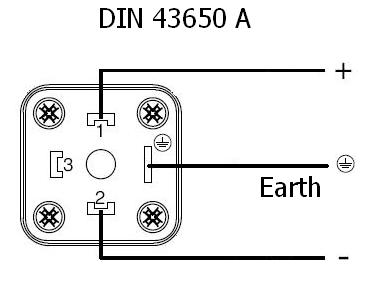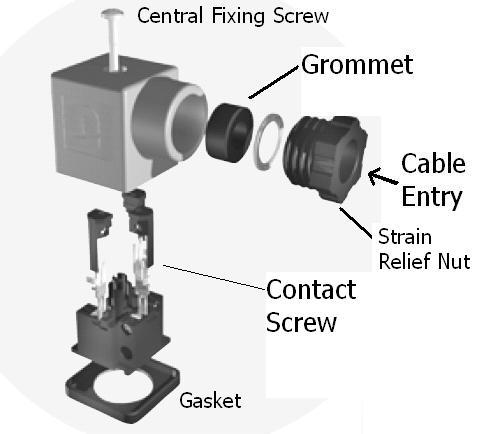How to wire a DIN43650 Electrical-Connector
Wiring, an Electrical DIN43650 Connector.

It is good practice to wire the electrical DIN connector, based on the same principles as you should do at home.
+ve power supply (Red or Brown wire) to terminal 1
-ve power return (Black or Blue) to terminal 2
It is however best practice and probably essential when working in damp environments to achieve the correct IP Protection Rating that you use the correct size of the cable into the conduit entry so that the rubber grommet fits firmly against the external cable sleeve to prevent water ingress into the connector.
Basic PG ratings are as follows
PG 9 is for cables 6 to 8 mm and PG 11 is for cables 8 to 10mm diameter.:

Also ensure correct fitting of the gasket between the connector and the coil with correct or adequate torque.
Typical Torque Settings for DIN connectors are:
Strain relief nut: 1.8 N/m +/- 10%
Central fixing screw: 0.4 N/m +/- 10%
Contact Screw: 0.2 N/m +/- 10%
It is also important as correct sizing and fitting not only protects the electrical system but also everything and everyone around the connector. Keeping the circuits safe, dry and helping to keep the cable securely fixed in place.
Orientation of the connector is also important

Make sure the cable conduit entry is facing down and that the electrical cable has sufficient slack in it so that it drops under the connector and back vertically up and into the conduit entry of the plug.
This will help prevent water ingress gravitating into the connector through the conduit entry, keeping it safe, so any moisture droplets will gravitate away from the conduit entry point.
Helpful Hint: Avoid cable entry pointing upwards, fasten locking screw securely and fill connector with silicone sealant in moist environments.
View all solenoid and electrical DIN43650 field mountable and pre-wired connectors here.
Read our FAQ section for helpful guides and technical information.
